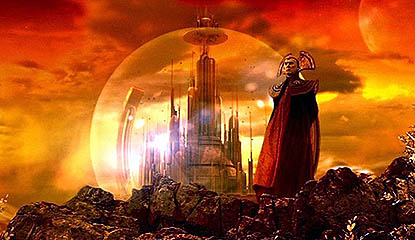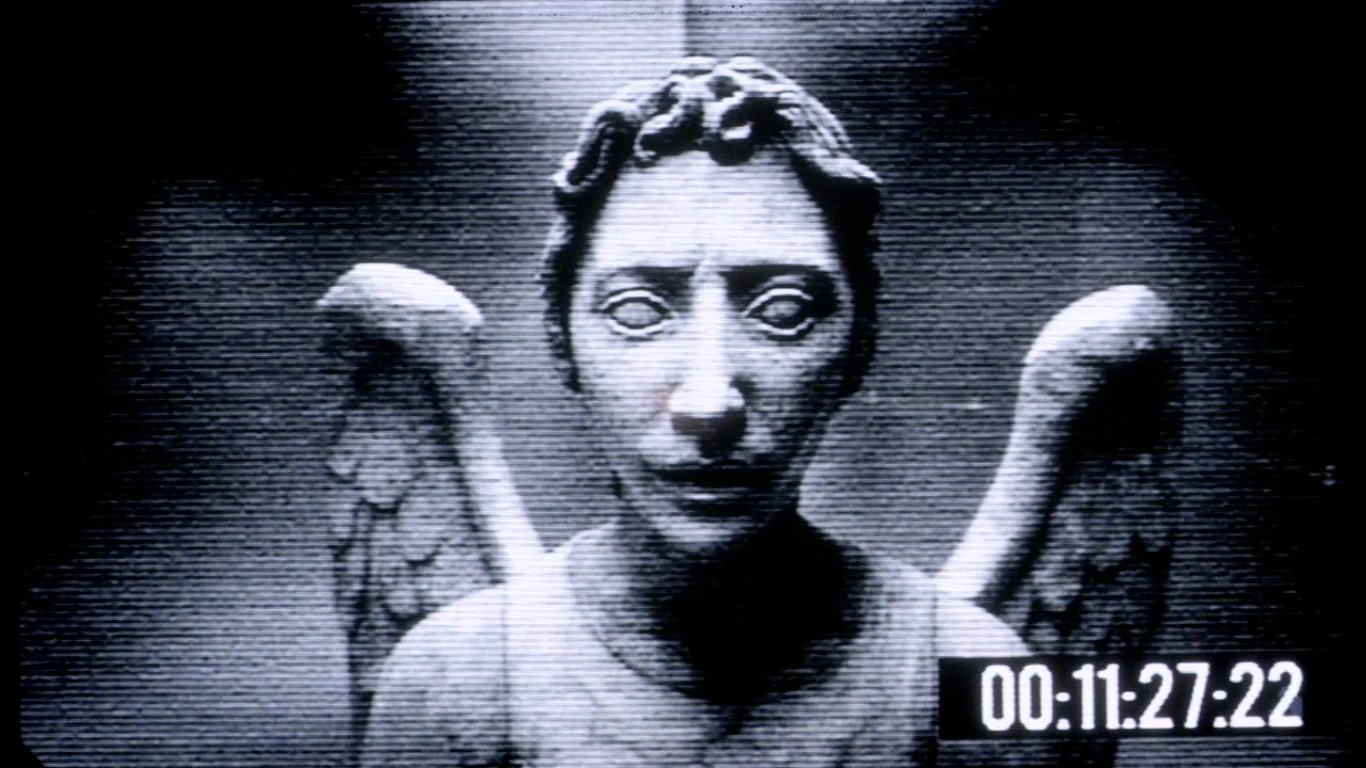Here's a brief-ish explanation.
Doctor Who is a British TV show created by Verity Lambert in the Sixties for the BBC. She wanted to come up with a show which was educational and yet entertaining and adventurous. The concept evolved into its present incarnation over more than fifty years, which in and of itself is a record for television programmes.
Doctor Who chronicles the adventures of The Doctor, an alien not born of this Earth, who nevertheless finds our world fascinating because he loves our species Homo sapiens for some unfathomable reason. The Doctor comes from a world called Gallifrey in a binary star system within the constellation of Kasterborous. The Doctor is what is known to the universe at large as a Time Lord.

Gallifrey, brought adjacent to Earth in the episode "The End of Time"

Arcadia, the capital of Gallifrey, and a Time Lord
The Doctor wanders throughout Time and Space, visiting different worlds in distant galaxies at various points in Time. His vessel is called the TARDIS, a time machine. TARDIS stands for Time And Relative Dimensions In Space. Time Lord technology, the most advanced technology in the universe, allows the TARDIS' true vast size to be placed in a transdimensional pocket; the part of the TARDIS that appears to the outside viewer looks like an old-fashioned blue British police telephone box.
The TARDIS was originally capable of changing into objects which matched the environment and era - large boulders, a freestanding pillar, a tree - but after landing in London in 1963, its chameleon circuit permanently fried leaving it stuck in the form which has become an iconic design, based on the design of the old-fashioned blue landline telephone booths set up on street corners in the Fifties and Sixties for people and police to report crimes.

TARDIS exterior
The interior of the TARDIS is vast, with corridors and rooms stretching outward in all directions - the vessel has often boasted a library, wardrobe and swimming pool at various times - but most of the time when the story takes place inside the TARDIS the only room you get to see is its bridge or Control Room, which always has a six-sided central table surrounding a Time Rotor, which oscillates up and down or rotates when the TARDIS is in motion.



The Doctor likes to change the interior of his TARDIS now and then like swapping out a desktop
Some other aspects of The Doctor's life which are established in the ongoing legend:-
Companions: The Doctor is usually accompanied by a succession of mostly human Companions. They come and they go. Occasionally, they die in his care, which leaves him devastated for prolonged periods. Without his Companions, The Doctor is practically helpless. With a Companion in tow, he is unstoppable.
Intellect: As a Time Lord, The Doctor's intellect is vast - beyond human genius. Despite that, he still makes mistakes. Sometimes, people and even whole species die as a result of these mistakes. He is also mildly telepathic, able to perform minor telepathic tricks on occasion. His strongest telepathic link is with the TARDIS, which also has a telepathic translation circuit - a convenient device to ensure that every alien encountered in the show speaks fluent English to the viewer.
Tools: The Doctor usually has with him a device called a sonic screwdriver. It is not a weapon. The worst he can do to someone with this device is assemble a flatpack cabinet at them.
Alien Physiology: The Doctor, as a Gallifreyan, has two hearts and is practically immortal. He can wear the same face for centuries, only gradually physically aging - he was still a child at the age of 98, was a teenager for about fifty years, and has gone through spans of linear time longer than entire human lifespans without getting visibly older. One Time Lord once commented how, barring accidents, a Time Lord could live for around ten thousand years. The Doctor himself commented that he could "live forever." The Doctor has been 500, 700, 900, 1200 and - in his current form - two thousand years old.
Regenerations: And when an accident does occur which could kill The Doctor, this Time Lord has one ultimate trick up his sleeve. He can regenerate.
Regeneration, for a Time Lord, does not mean that his wounds seal up as if he had some sort of healing factor. Regeneration means that the Time Lord undergoes a complete metamorphosis, shedding his old form in a blast of golden energy and adopting a brand new form with a wholly different body, face, features and personality. Regenerations tend to usher in a whole new era of adventures for The Doctor and his Companions, each with their own unique feel to them.
The only limit to this is the number of regenerations available to Time Lords: until 2014, no Time Lord could regenerate more than twelve times, his thirteenth regeneration being his last - the regeneration in which he really could die forever.
At various times, The Doctor has been portrayed by a number of actors, whose names and line of succession is as important to us Brits and Whovians as the names of the historical Kings and Queens of England:-
William Hartnell ("One") (1963 11 23 – 1966 10 29) |
Patrick Troughton ("Two") (1966 10 29 – 1969 06 21) |
Jon Pertwee ("Three") (1970 03 01 – 1974 06 08) |
Tom Baker ("Four") (1974 06 08 – 1981 03 21) |
Peter Davison ("Five") (1981 03 21 – 1984 03 16) |
Colin Baker ("Six") (1984 03 16 – 1986 12 06) |
Sylvester McCoy ("Seven") (1987 09 07 – 1989 12 06) |
Paul McGann ("Eight") (1996 05 27 and 2013 11 14) |
John Hurt ("War") (2013 05 18 and 2013 11 23) |
Christopher Eccleston ("Nine") (2005 03 26 – 2005 06 18) |
David Tennant ("Ten") (2005 06 18 – 2010 01 01 and 2013 11 23) |
Matt Smith ("Eleven") (2010 01 01 – 2013 12 25) |
Peter Capaldi ("Twelve") (2013 11 23 and 2013 12 25, then 2014 08 23 – the present) |
Monsters: The Doctor regularly faces off against a vast array of often-terrifying alien species, most of which seem to be bent on dominating the universe, conquering various species or simply annihilating everything living that is not of their kind. These monsters include:-
Daleks - xenophobic mutated creatures, little more than blobs of jelly with tentacles, encased within terrifying mobile war machines. Their ultimate goal is to eliminate all sentient life that is not Dalek. Their characteristic war cry is an electronic scream - "EXTERMINATE!"

Cybermen - originally humans from a planet described as "Earth's twin planet" Mondas, Cybermen gradually came about as a result of cybernetics gone horribly out of control, resulting in the species turning into monstrous metallic armoured cyborgs with, again, a small amount of humanoid matter inside them. Cybermen are more machine than man, and they are twisted and evil because of their drive to assimilate ("upgrade") anything that moves to turn their victims into more Cybermen.

Sontarans - A short, spud-headed cloned species, Sontarans are hatched for one purpose only: war and conquest. In the Victorian London setting which Doctor Who occasionally visits, Madam Vashtra's butler Strax is a Sontaran, genetically modified for medic duties yet incapable of completely forgetting his warrior ethic.

Silurians - The original dominant sentient species on Earth, the Silurians were forced into space or into deep hibernation by the extinction level event on Earth during the late Cretaceous which brought about the end of the era of the dinosaurs. This race of sentient reptilians, living dinosaurs themselves, believe themselves to be the true rulers of the Earth, with humans being a bit of a vulgar Johnny-come-lately; after all, the only mammals on the Earth when they once rules were the ratlike egg thieves which occasionally infested their nurseries, and primates hadn't even evolved yet.
Madam Vashtra in the Victorian London setting is one such Silurian. She is happily married to a human, Jenny.

Weeping Angels: Cruel aliens from the dawn of the universe that look like statues, these terrifying assassins have a powerful defence mechanism - they are quantum-locked. For as long as they are observed, they turn into stone, but once they are not observed they move like lightning. And whatever they touch ends up stuck in the past, where they are forced to live out their lives and die while the Angel feasts off the lost life that would have been lived. In a cruel twist of fate, the victim only lives long enough to die at the exact moment he or she got sent back into the past. Don't blink. Blink, and you're dead.

But by far the most monstrous aliens The Doctor encounters in his travels are, in fact, the worst aliens of them all.
Human: Sometimes, the most alien creature in the universe, alien even to The Doctor, is a vain, greedy or ambitious human. They can be found everywhere in the Doctor Who universe; and they are often responsible for some of the worst and ugliest things to ever happen on the show.
So that is Doctor Who in a nutshell for non-Whovians. Please sit back and enjoy the show, and remember - the weirdness you see has been brewing for more than fifty years. So it is going to be a pretty heady rush.
No comments:
Post a Comment
Speak, Citizen of The Universe.